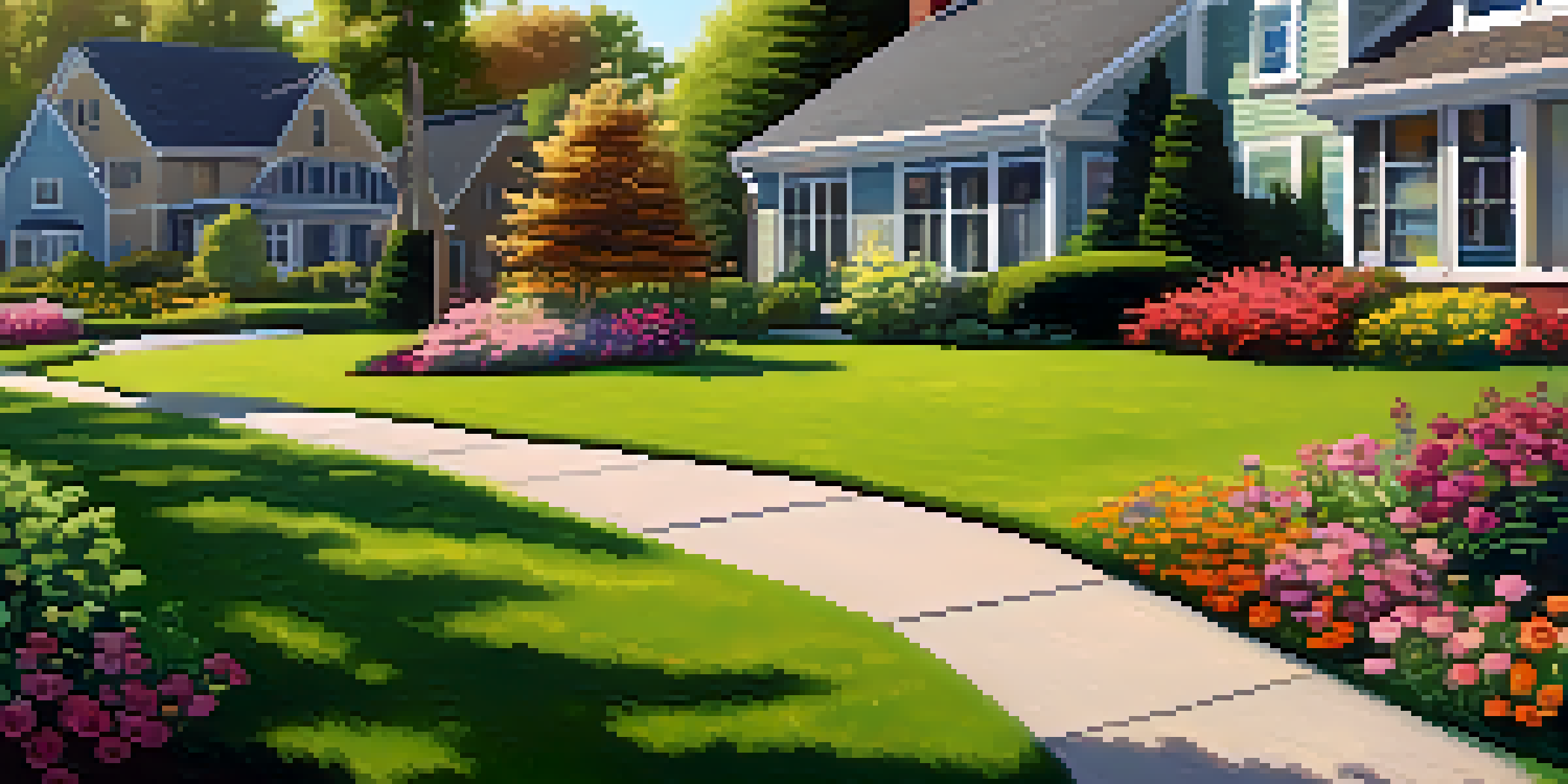Maintaining Your Lawn for Better Curb Appeal

The Importance of Lawn Care for Curb Appeal
A well-maintained lawn can dramatically enhance your home's curb appeal. It’s often the first thing visitors and potential buyers notice, setting the tone for the entire property. Just like a well-tailored outfit, a neat lawn can make a great impression.
The grass is always greener where you water it.
Think about it: a lush, green lawn is like a welcoming handshake that invites people in. On the other hand, a patchy, overgrown yard can send the wrong message, suggesting neglect or lack of care. Investing time in your lawn is akin to investing in your home’s overall value.
Moreover, a beautiful lawn doesn’t just look good; it can also increase your property value. Homebuyers frequently prioritize landscaping in their search, making it a key factor in selling your home for a better price.
Choosing the Right Grass for Your Region
Selecting the right type of grass is crucial for a healthy lawn. Different regions have varying climates, which influence the type of grass that will thrive. For instance, cool-season grasses like Kentucky bluegrass do well in northern climates, while warm-season varieties like Bermuda grass shine in southern areas.

Understanding your local climate can save you time and money in the long run. When you choose grass suited to your environment, you’ll find it easier to maintain and will spend less on water and fertilizer. Think of it as finding the perfect fit for your personal style; it just works better.
Lawn Care Boosts Curb Appeal
A well-maintained lawn significantly enhances your home's first impression and overall value.
Additionally, using native grasses can enhance biodiversity in your yard. They require less maintenance and water, making them a sustainable choice for both your lawn and the environment.
Regular Mowing for a Neat Appearance
Mowing your lawn is one of the simplest yet most effective ways to maintain curb appeal. A regular mowing schedule not only keeps your grass at a healthy height but also encourages a denser and more lush lawn. Ideally, you should aim to mow once a week during the growing season.
A beautiful lawn is a reflection of a well-maintained home.
When mowing, remember the one-third rule: never cut more than one-third of the grass height at once. This helps prevent stress on the grass, allowing it to recover and grow stronger. Picture it like getting a trim rather than a drastic haircut; it’s much healthier for your hair—or in this case, your grass.
Also, consider the direction you mow each time. Altering your mowing pattern helps prevent soil compaction and promotes upright growth, giving your lawn that enviable, manicured look.
Fertilization: Feeding Your Lawn Right
Just like we need nutrients to thrive, your lawn requires proper fertilization to stay healthy. Applying fertilizer helps replenish the essential nutrients that grass loses over time. A well-fed lawn is typically greener and more resilient to pests and diseases.
Timing is key when it comes to fertilizing. Spring and fall are ideal seasons for most grasses, as this is when they actively grow. Think of it as feeding your lawn during its peak growing seasons, helping it to flourish.
Choose Grass for Your Region
Selecting grass suited to your local climate ensures a healthier lawn that requires less maintenance.
It's important to choose the right type of fertilizer, too. Slow-release fertilizers provide nutrients gradually, reducing the risk of over-fertilization, which can harm your grass and the environment. Reading the labels and understanding your lawn's needs can make a big difference.
Watering Wisely: The Right Amount Matters
Watering your lawn adequately is essential for maintaining its health and appearance. Generally, grass needs about one inch of water per week, whether from rainfall or irrigation. However, it's crucial to water deeply and less frequently to encourage deep root growth.
Consider watering early in the morning to reduce evaporation and fungal diseases. Imagine your lawn sipping water like you do your morning coffee; it’s best enjoyed slowly and steadily. This practice not only helps conserve water but also keeps your grass hydrated.
Using a rain gauge can help you monitor how much water your lawn is receiving. By keeping track, you can adjust your watering schedule accordingly, ensuring your lawn stays vibrant without wasting water.
Aeration: Boosting Grass Health
Aeration is a crucial lawn care practice that often gets overlooked. By perforating the soil with holes, you allow air, water, and nutrients to penetrate the grassroots more effectively. This process encourages healthier growth and improves overall lawn resilience.
Think of aeration as giving your lawn a breath of fresh air. It alleviates soil compaction, which can suffocate roots and hinder growth. Performing aeration once or twice a year can go a long way in maintaining a lush green lawn.
Natural Methods for Weeds and Pests
Using natural approaches for weed and pest management helps maintain lawn health and supports local ecosystems.
There are various methods for aerating, such as using a spike aerator or a core aerator. Core aerators remove small plugs of soil, providing the best results for your lawn. Implementing aeration can transform your lawn from simply surviving to truly thriving.
Dealing with Weeds and Pests Naturally
Weeds and pests can quickly detract from your lawn's appearance and health. Instead of resorting to harsh chemicals, consider natural methods for managing these unwelcome guests. Maintaining a healthy lawn through proper mowing, watering, and fertilization can prevent many weed and pest issues.
For instance, using mulch around flower beds can help suppress weed growth while retaining soil moisture. It’s like putting on a protective layer; it keeps weeds at bay while nourishing your plants. Additionally, hand-pulling weeds can be a satisfying way to keep your lawn looking pristine.

If pests become a problem, consider introducing beneficial insects like ladybugs or using organic pest control methods. This approach not only protects your lawn but also supports a healthy ecosystem in your yard.